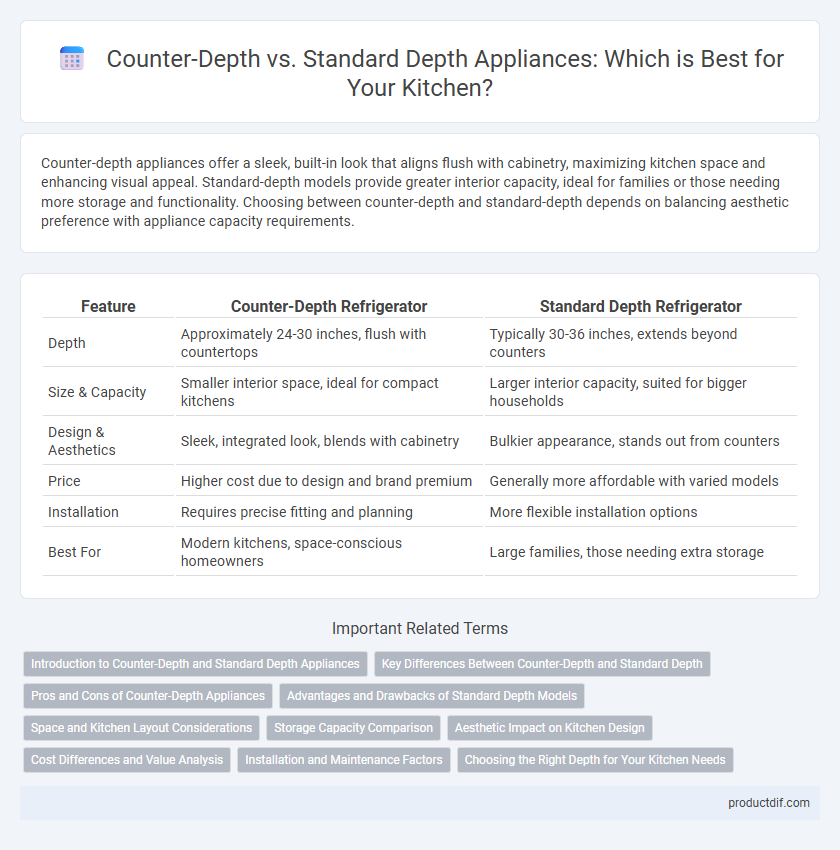Counter-depth appliances offer a sleek, built-in look that aligns flush with cabinetry, maximizing kitchen space and enhancing visual appeal. Standard-depth models provide greater interior capacity, ideal for families or those needing more storage and functionality. Choosing between counter-depth and standard-depth depends on balancing aesthetic preference with appliance capacity requirements.
Table of Comparison
| Feature | Counter-Depth Refrigerator | Standard Depth Refrigerator |
|---|---|---|
| Depth | Approximately 24-30 inches, flush with countertops | Typically 30-36 inches, extends beyond counters |
| Size & Capacity | Smaller interior space, ideal for compact kitchens | Larger interior capacity, suited for bigger households |
| Design & Aesthetics | Sleek, integrated look, blends with cabinetry | Bulkier appearance, stands out from counters |
| Price | Higher cost due to design and brand premium | Generally more affordable with varied models |
| Installation | Requires precise fitting and planning | More flexible installation options |
| Best For | Modern kitchens, space-conscious homeowners | Large families, those needing extra storage |
Introduction to Counter-Depth and Standard Depth Appliances
Counter-depth appliances are designed to align flush with cabinetry, offering a sleek, built-in look while saving kitchen space with depths typically around 24 to 30 inches. Standard-depth appliances, measuring approximately 30 to 36 inches deep, extend beyond cabinetry for increased storage and capacity but may disrupt the kitchen's seamless appearance. Choosing between counter-depth and standard-depth appliances depends on balancing kitchen space, storage needs, and aesthetic preferences.
Key Differences Between Counter-Depth and Standard Depth
Counter-depth appliances are designed to fit flush with cabinetry, typically measuring around 24 to 30 inches deep, optimizing kitchen space and creating a streamlined look. Standard-depth appliances usually extend 25 to 30 inches beyond countertops, providing greater internal capacity but protruding into the kitchen workspace. The choice between counter-depth and standard-depth impacts kitchen aesthetics, storage volume, and overall functionality depending on user priorities.
Pros and Cons of Counter-Depth Appliances
Counter-depth appliances offer a sleek, built-in look by aligning flush with cabinetry, maximizing kitchen space and improving traffic flow. Their reduced depth limits internal capacity, potentially restricting storage for larger households or bulky items. Installation costs can be higher due to custom cabinetry adjustments and limited model availability compared to standard-depth appliances.
Advantages and Drawbacks of Standard Depth Models
Standard depth appliances offer increased interior capacity, making them ideal for larger households requiring more storage space for food and kitchen essentials. Their extended depth often results in a more traditional built-in appearance but can protrude beyond counters, potentially disrupting kitchen flow and reducing aisle space. Despite requiring additional clearance, standard depth models generally provide a better value for consumers prioritizing volume over a streamlined kitchen design.
Space and Kitchen Layout Considerations
Counter-depth appliances measure approximately 24 to 30 inches deep, aligning closely with the front of standard countertops to create a sleek, streamlined kitchen appearance and allowing for easier movement in narrow spaces. Standard-depth appliances typically extend 25 to 28 inches beyond countertops, offering greater interior capacity but requiring more clearance, which can impact kitchen layout and traffic flow. Choosing between counter-depth and standard-depth appliances depends on available kitchen space, desired aesthetics, and the balance between appliance capacity and open floor area.
Storage Capacity Comparison
Counter-depth appliances typically offer a sleek, space-saving design but provide less interior storage capacity compared to standard-depth models, which extend further into the kitchen for maximum storage. Standard-depth refrigerators and appliances generally range from 30 to 36 inches in depth, delivering higher cubic footage, often between 20 to 30 cubic feet, ideal for larger families or bulk storage needs. Counter-depth units usually measure 24 to 30 inches deep and offer around 15 to 22 cubic feet of usable space, prioritizing kitchen aesthetics over maximum capacity.
Aesthetic Impact on Kitchen Design
Counter-depth refrigerators create a sleek, built-in appearance by aligning with cabinet edges, enhancing kitchen aesthetics and providing a streamlined, modern look. Standard-depth appliances protrude beyond cabinetry, which can disrupt the visual flow and make small kitchens appear cramped. Opting for counter-depth designs improves spatial harmony and contributes to a high-end, custom kitchen feel.
Cost Differences and Value Analysis
Counter-depth appliances typically cost 10-20% more than standard-depth models due to their streamlined design and space-saving features. The higher price reflects enhanced aesthetics and better integration in kitchens, often adding long-term value through improved resale appeal. Evaluating cost differences involves balancing upfront expenses with the potential for increased home value and kitchen functionality.
Installation and Maintenance Factors
Counter-depth appliances simplify installation with their flush alignment to cabinetry, reducing the need for extensive modifications and enabling easier access for routine maintenance. Standard-depth models require more space, often complicating placement in tight kitchens and making service access more cumbersome. Choosing counter-depth options minimizes installation costs and streamlines maintenance by allowing quicker component reach and less frequent structural adjustments.
Choosing the Right Depth for Your Kitchen Needs
Counter-depth appliances offer a sleek, built-in look that aligns with standard countertop edges, maximizing kitchen space and providing a streamlined aesthetic. Standard-depth appliances extend beyond the counter, offering greater storage capacity and cooking volume, ideal for larger kitchens or families needing extra functionality. Selecting the right depth depends on balancing your kitchen layout, storage requirements, and design preferences to achieve optimal efficiency and style.
Counter-Depth vs Standard Depth Infographic

 productdif.com
productdif.com